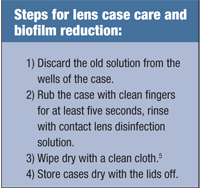 Biofilms are everywhere in everyday life, such as in the plaque on your teeth, the build up in pipes, the slime on rock and inside contact lens cases. A biofilm is a group of microorganisms growing on a solid surface (living or non-living) and are generally embedded within a self-produced matrix of extracellular polymeric substance (EPS). The EPS consists of extracellular DNA, proteins, and polysaccharides. The EPS protects the cells within it and facilitates communication between the microorganisms through biochemical signals.
Biofilms are everywhere in everyday life, such as in the plaque on your teeth, the build up in pipes, the slime on rock and inside contact lens cases. A biofilm is a group of microorganisms growing on a solid surface (living or non-living) and are generally embedded within a self-produced matrix of extracellular polymeric substance (EPS). The EPS consists of extracellular DNA, proteins, and polysaccharides. The EPS protects the cells within it and facilitates communication between the microorganisms through biochemical signals.
Formation of a biofilm begins with the attachment of free-floating (planktonic) microorganisms to a surface. These first colonies adhere to the surface initially through weak, reversible bonds. Other planktonic cells can then attach to the adhered bacteria. This process of continued adhesion eventually leads to many layers of microorganisms and EPS on the surface. If the colonies are not immediately separated from the surface, they can anchor themselves more permanently. Once colonization has begun, the biofilm grows through a combination of cell division and recruitment. A biofilm can be formed by a single microorganism species, but more often biofilms consist of many species of bacteria, as well as fungi, algae, and protozoa.
 Microorganisms living in a biofilm can have significantly different properties from planktonic microorganisms.1 Biofilms have increased resistance to detergents and antibiotics, since the EPS and the outer layer of cells protect the interior of the community. A biofilm also produces high levels of antibiotic degrading enzymes. Repeated use of antimicrobial agents on biofilms can cause bacteria within the biofilm to develop an increased resistance to biocides. The bacteria within the biofilm remain healthy, and the biofilm can regrow.
Microorganisms living in a biofilm can have significantly different properties from planktonic microorganisms.1 Biofilms have increased resistance to detergents and antibiotics, since the EPS and the outer layer of cells protect the interior of the community. A biofilm also produces high levels of antibiotic degrading enzymes. Repeated use of antimicrobial agents on biofilms can cause bacteria within the biofilm to develop an increased resistance to biocides. The bacteria within the biofilm remain healthy, and the biofilm can regrow.
Bacteria that is attached to a surface (sessile) turns on stress-response genes and renders the biofilm more resistant when exposed to environmental stresses, making it a significantly different organism to deal with compared to planktonic organisms. Biofilm associated infections may be more virulent and aggressive and require different clinical approaches to treatment.1-3 Data suggests that microbial keratitis events involve biofilm forming organisms.2
Studies have shown the bacterial contamination of contact lens cases may be as high as 81% and may be responsible for transferring organisms from the case to the lens to the eye.4 Removing the biofilm from the contact lens case is an important step in lens care compliance.
Numerous studies have now shown that mechanically wiping the contact lens case dry after lens removal will mechanically disrupt the biofilm and will reduce the lens case bioburdeon significantly.5-7 Silver impregnated lens cases have less biofilm formation than polypropylene lens cases.8
Biofilms are part of everyday life and are a significant factor in the development of microbial keratitis events. Biofilms can form daily in contact lens cases. Mechanical disruption and drying of the lens case is the best way to protect lens wearers from lens case biofilm associated infections.
1. Lazr V, Chifiriuc MC. Medical significance and new therapeutical strategies for biofilm associated infections. Roum Arch Microbiol Immunol. 2010 Jul-Sep;69(3):125-38.
2. Tam C, Mun JJ, Evans DJ, Fleiszig SM. The impact of inoculation parameters on the pathogenesis of contact lens-related infectious keratitis. Invest Ophthalmol Vis Sci. 2010 Jun;51(6):3100-6.
3. Robertson DM, Parks QM, Young RL, Kret J, Poch KR, Malcolm KC, Nichols DP, Nichols M, Zhu M, Cavanagh HD, Nick JA. Disruption of contact lens-associated Pseudomonas aeruginosa biofilms formed in the presence of neutrophils. Invest Ophthalmol Vis Sci. 2011 Apr 27;52(5):2844-50.
4. Szczotka-Flynn LB, Pearlman E, Ghannoum M. Microbial contamination of contact lenses, lens care solutions, and their accessories: a literature review. Eye Contact Lens. 2010 Mar;36(2):116-29.
5. Wu YT, Zhu H, Wilcox M, Stapleton F Removal of Biofilm from contact lens storage cases. Invest Ophthalmol Vis Sci 2010Dec; 51(12) 6329-33.
6. Boost M, Shi GS, Cho P. Adherence of acanthamoeba to lens cases and effects of drying on survival. Optom Vis Sci. 2011 Jun;88(6):703-7.
7. Wu YT, Zhu H, Willcox M, Stapleton F. The effectiveness of various cleaning regimens and current guidelines in contact lens case biofilm removal. Invest Ophthalmol Vis Sci. 2011 Jul 15;52(8):5287-92.
8. Wu YT, Zhu H, Willcox M, Stapleton F. Impact of cleaning regimens in silver-impregnated and hydrogen peroxide lens cases. Eye Contact Lens. 2011 Nov;37(6):365-9.


